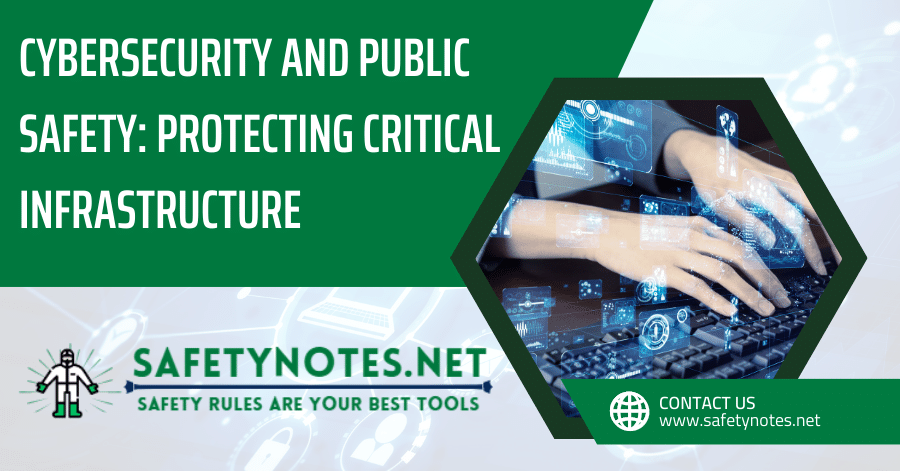
Understanding the intersections between cybersecurity and public safety is essential in today’s digitized world. Modern society is increasingly reliant on a variety of interconnected networks and systems that make up our critical infrastructure. If these systems are compromised, the implications for public safety can be severe.
Importance of Cybersecurity for Public Safety
Cybersecurity is no longer a matter of protecting information and data alone; it now plays a pivotal role in safeguarding public safety. The well-being of the public often hinges on the secure operation of critical infrastructure systems, from transportation networks to energy supplies to communication systems. Hence, ensuring these systems are protected against cyber threats is paramount.
Overview of Critical Infrastructure Systems
Critical infrastructure refers to the physical and virtual systems and networks that are so vital to the country that their incapacitation or destruction would have a debilitating effect on national security, economic security, public health, or safety. Examples include:
- Transportation systems such as air traffic control systems, highway networks, and rail systems.
- Energy systems like power plants, electrical grids, and oil and gas refineries.
- Communication networks include telecommunication systems, satellite networks, and internet connectivity.
Understanding the Cybersecurity Threats to Public Safety
The Vulnerability of Critical Infrastructure
Despite their importance, critical infrastructure systems are vulnerable to cyber-attacks. Their interconnectedness, coupled with the increasing sophistication of cyber threats, can create a perfect storm for wide-scale disruptions.
Types of Cyber Threats
Some of the common cyber threats to critical infrastructure include:
- Malware: Malicious software designed to damage, disrupt, or gain unauthorized access to a computer system.
- Phishing: Cyber attack that uses disguised email as a weapon. The goal is to trick the email recipient into believing that the message is something they want or need and to click a link or download an attachment.
- DDoS Attacks: Distributed Denial-of-Service (DDoS) attacks occur when multiple systems flood the bandwidth or resources of a targeted system, usually a web server, causing it to crash and cease providing its service.
Consequences of Cyber Attacks on Public Safety
The repercussions resulting from cyber attacks on the well-being of the general public are of significant magnitude. The implications and aftermath of cyber attacks targeting public safety are vast and extensive in their scope, deeply impacting the overall welfare and security of the broader community. The wide-ranging consequences stemming from malicious cyber attacks that specifically target the safety and security of the public are immense and far-reaching, exerting a substantial and profound impact on the overall well-being, protection, and tranquility of the entire community as a whole.
The Role of Critical Infrastructure in Public Safety
Transportation Networks and Public Safety
Transportation networks are the lifelines of society. A cyber attack could disrupt these systems, leading to significant delays, accidents, and in some cases, loss of life. For instance, a hacker could manipulate traffic light systems, causing widespread confusion and accidents.
Energy Systems and Public Safety
Energy systems, like the electric grid, are crucial for powering homes, businesses, and public services. A successful cyber attack could result in widespread blackouts, impacting everything from hospital services to water treatment plants.
Communication Networks and Public Safety
Communication networks underpin our ability to coordinate and respond to emergencies. A cyber attack on these systems could lead to a breakdown in emergency communications, and impending disaster response efforts.
Measures and Technologies to Protect Critical Infrastructure
Security Policies and Procedures
Establishing robust security policies and procedures is the first line of defense against cyber threats. This might include measures like multi-factor authentication, encryption, and regular security audits.
Advanced Cybersecurity Technologies
Implementing advanced cybersecurity technologies can help detect and respond to threats faster. These might include:
- Intrusion Detection Systems (IDS): These intelligent systems employ sophisticated algorithms and behavioral analysis techniques to continuously monitor network traffic, promptly identifying any suspicious activities or unauthorized access attempts.
- Security Information and Event Management (SIEM) systems: These robust platforms aggregate and analyze extensive sets of security event data from diverse sources, enabling you to proactively correlate and investigate potential security incidents, thereby enhancing your incident response capabilities.
- Next-generation firewalls: These highly evolved firewalls leverage advanced features such as application awareness, deep packet inspection, and user-based policies to fortify your network against emerging threats. With enhanced visibility and granular control, they enable better protection against sophisticated attacks and persistent threats.
Role of AI and Machine Learning in Cybersecurity
AI and machine learning can analyze vast amounts of data to identify patterns and detect anomalies that may indicate a cyber attack. These technologies can also automate responses to threats, increasing the speed and efficiency of the response.
By harnessing artificial intelligence (AI) and machine learning (ML) capabilities, the field of cybersecurity gains significant advantages. These cutting-edge technologies excel in sifting through vast quantities of data, diligently recognizing intricate patterns while promptly spotting any irregularities that might indicate an impending cyber attack. Moreover, the utilization of AI and ML empowers automated responses, allowing for swift and efficient countermeasures against potential threats. Through this integration, cybersecurity defenses are fortified, equipped with the ability to proactively safeguard critical systems and networks against malicious intrusions.
Training and Awareness Programs
Regular training and awareness programs can ensure that all employees understand their role in protecting critical infrastructure, from recognizing potential threats to following security procedures.
How Technology Enhances Public Safety and Efficiency
The integration of innovative technology into public safety operations has resulted in substantial advancements, creating safer communities and more efficient emergency response mechanisms. A major way in which technology makes public safety safer and more efficient is through enhanced emergency responses. For instance, drones with high-resolution cameras and sensors can survey disaster-stricken areas rapidly, providing invaluable, real-time data to emergency responders. This drastically reduces the time needed to assess situations and allows for quicker, more informed decisions.
Similarly, advanced communication technologies have revolutionized information exchange during emergencies. The advent of Next Generation 911 systems has ensured seamless, real-time sharing of multimedia information, improving coordination between the public and emergency services. Data analysis tools have also become instrumental in public safety, with predictive policing tools analyzing crime data to anticipate crime hotspots, enabling preemptive action. Additionally, the Internet of Things (IoT) has a significant role in public safety, with devices that monitor public spaces, infrastructure, and traffic flows. Smart city technologies, for instance, can promptly respond to incidents and adjust traffic light timings to mitigate congestion, significantly enhancing public safety.
Some practical examples include:
- Drones provide real-time visuals of a wildfire to inform firefighting efforts.
- A Next Generation 911 in (U.S) system enables a caller to share live video of a crime scene with police.
- Predictive policing software identifies a potential surge in burglaries in a particular neighborhood, leading to increased patrols.
- IoT-based smart city technology identifies a major traffic jam and adjusts traffic light timings to ease congestion.
Conclusion
In today’s digitized world, cybersecurity is crucial for ensuring public safety. Critical infrastructure systems, such as transportation, energy, and communication networks, are vulnerable to cyber attacks that can have severe consequences. Disruptions of these systems can lead to accidents, blackouts, and compromises in emergency services. To protect critical infrastructure, robust security policies, advanced cybersecurity technologies, and training programs are essential. Additionally, the integration of innovative technologies enhances public safety and efficiency. Drones, advanced communication systems, data analysis tools, and IoT devices play a significant role in emergency response and proactive measures. By prioritizing cybersecurity and leveraging technology, we can safeguard critical infrastructure and protect public safety.



Express your appreciation for the insightful blog post. Let the author know that you found the discussion on cybersecurity for public safety and critical infrastructure protection highly informative and timely.
Express your appreciation for the insightful blog post. Let the author know that you found the discussion on cybersecurity for public safety and critical infrastructure protection highly informative and timely.